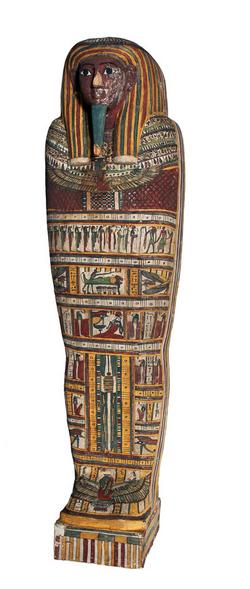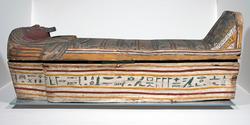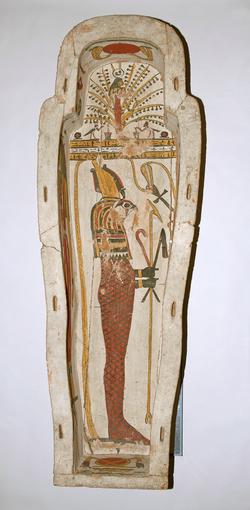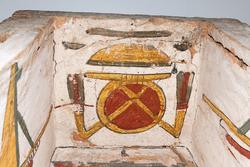Current Location: Exhibition: Exhibition: Made in Ancient Egypt, 3 October 2025 – 12 April 2026 (Mellon Gallery)
Titles
Coffin set of Pakepu
Entities
Categories
Description
Wooden coffin set belonging to a man named Pakepu comprising two anthropoid coffins complete with lids and boxes. The coffin set is attributed to Thebes and on stylistic grounds dates to the Late Period (probably the end of the 25th Dynasty). The smaller coffin of the two, known as the inner coffin, nests inside the larger, intermediate one. Both coffins were probably then housed inside a larger, outer 'qersu' coffin.
The coffins are painted and decorated in a colour palette of red, blue, green and two different shades of yellow and bear a range of inscriptions and iconography, many of which are appeals to the gods, especially Osiris, for the provision of food offerings and all good, sweet and delicious things.
The inner coffin interestingly bears a complex layered structure above the wooden carcass made from a combination of fibrous glue, linen and layers of calcite paste, reminiscent of the technique of cartonnage. This association is supported by the presence of a substantial plinth under Pakepu's feet, like those used to attach the footboard in cartonnage coffins.
Wooden coffin set belonging to a man named Pakepu comprising two anthropoid coffins complete with lids and boxes. The coffin set is attributed to Thebes and on stylistic grounds dates to the Late Period (probably the end of the 25th Dynasty). The smaller coffin of the two, known as the inner coffin, nests inside the larger, intermediate one. Both coffins were probably then housed inside a larger, outer 'qersu' coffin.
The coffins are painted and decorated in a colour palette of red, blue, green and two different shades of yellow and bear a range of inscriptions and iconography, many of which are appeals to the gods, especially Osiris, for the provision of food offerings and all good, sweet and delicious things.
The inner coffin interestingly bears a complex layered structure above the wooden carcass made from a combination of fibrous glue, linen and layers of calcite paste, reminiscent of the technique of cartonnage. This association is supported by the presence of a substantial plinth under Pakepu's feet, like those used to attach the footboard in cartonnage coffins.
For more extensive information on this coffin set, refer to the Fitzwilliam Egyptian Coffins online resource - www.egyptiancoffins.org/coffins/pakepu.
Legal notes
Given by Edward (VII), Prince of Wales, 1869
Acquisition and important dates
Method of acquisition: Given
(1869)
by
Edward (VII), Prince of Wales
Dating
Kushite-Late Period
25th Dynasty
26th Dynasty
Circa
-0680
-
Circa
-0664
Project
Components of the work
Outer Coffin
Length 209 cm
Inscription or legends present
Inscription present: Intermediate coffin lid - First register, on either side of winged sundisk topped by uraei in the centre.
- Location: Intermediate coffin lid - first register.
- Method of creation: Painted
Inscription present: Twenty vertical columns of inscription, offering formula
- Location: Intermediate coffin lid - Third Register
Inscription present: 6 columns of text (three either side) flanking the scene of the deceased on a funerary bier, where Anubis is tending to Pakepu.
PROPER LEFT
- Location: Intermediate coffin lid - Register 4, deceased on bier scene
Inscription present: 6 columns of text (three either side) flanking the scene of the deceased on a funerary bier, where Anubis is tending to Pakepu.
PROPER RIGHT
- Location: Intermediate coffin lid - Register 4, deceased on bier scene
Inscription present: Offering formula/owner filiation, written in retrograde
- Text: 20 lines of vertical inscription, offering formula, and owner filiation.
- Location: Intermediate coffin lid -Register 5, 20 lines of inscription
Inscription present: Two areas of text, flanking depiction of mummified Sokar on either side, four columns of text each.
- Location: Intermediate coffin lid - Register 6, flanking Sokar
Inscription present: 18 vertical columns of text
- Location: Intermediate coffin lid - Register 7, 18 columns of text
Inscription present: Upper part of footboard, flanking Sokar either side, four rows of inscription (carelessly written)
- Location: Intermediate coffin lid - upper part of footboard
Inscription present: Single band of hieroglyphic text extending around the entirety of the box framed by three horizontal bands of painted decoration above and below
- Location: Intermediate coffin box exterior
Inscription present: Three lines of horizontal inscriptions
- Location: Intermediate box interior
Inscription present: Interior, two small inscriptions situated alongside representation of goddesses Isis (proper right) and Nephthys (proper left)
- Text: Offering formula
- Location: Intermediate box interior (head end)
Inscription present: Inscriptions on lower third of the lid, in six registers, around Abydos fetish
- Location: Inscriptions on lower third of the lid, around Abydos fetish
Inscription present: On underside of box, two columns of text on either side of large djed-pillar in centre.
- Location: Inner coffin box exterior
References and bibliographic entries
Related exhibitions
Identification numbers
Accession number: E.2.1869
Primary reference Number: 49054
Oldadmincategory: SS
Stable URI
Audit data
Created: Saturday 6 August 2011
Updated: Monday 6 October 2025
Last processed: Thursday 27 November 2025
Associated departments & institutions
Owner or interested party:
The Fitzwilliam Museum
Associated department:
Antiquities
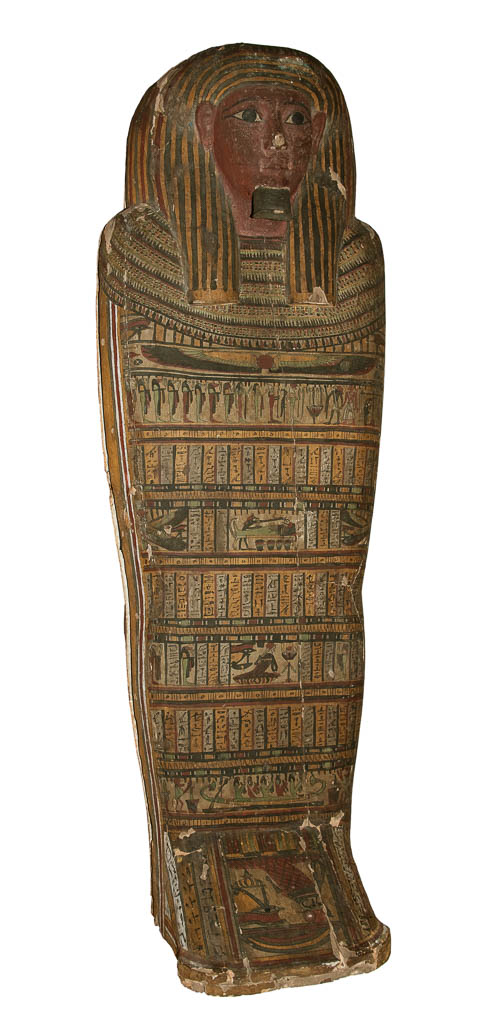
 IIIF Manifest
IIIF Manifest
